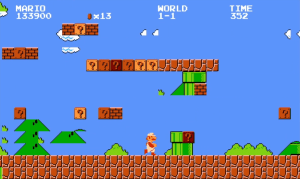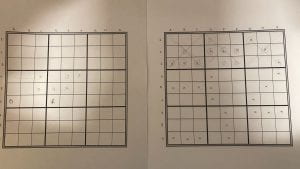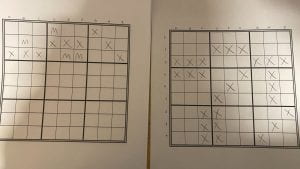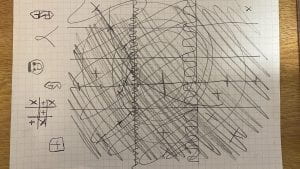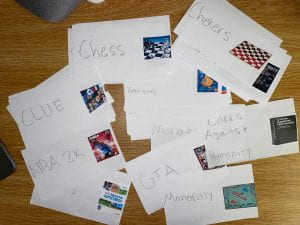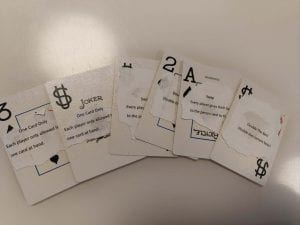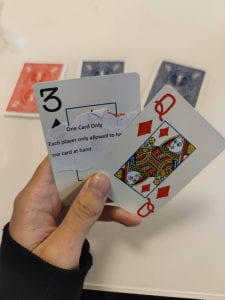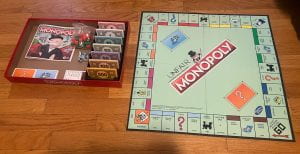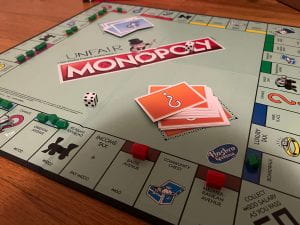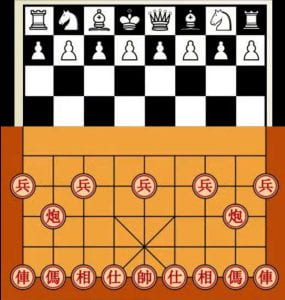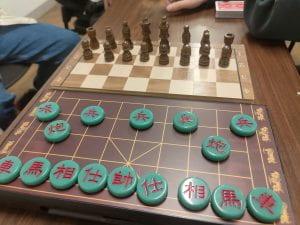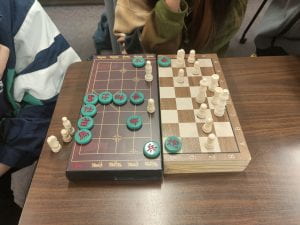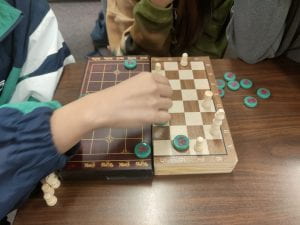Overview
For my appropriation piece, I created a game called “スクランブル (Sukuramburu).” The name comes from the Japanese-ified version of the word “scramble.” This game is a fun word game that uses the flexible, “scrambled” grammar of the Japanese language and applies it to English in order to make for a word guessing game.
Setup/Rules
Necessary Materials: Six-sided die, writing utensils, 2x small pieces of paper (where x = amount of players), x amount of Sentence Cards (shown in the Documentation section), and a basic understanding of English grammar rules and devices.
- Split the group of 4+ players into 2 even teams.
- Have the two teams together decide on a theme/prompt for this round of gameplay. Make sure to pick themes that everyone is knowledgeable about and have a lot of different places, people, or things associated with it. Examples of good themes would be “Household objects,” “Boston,” and “SpongeBob SquarePants.”
- Have each person take 2 small pieces of paper and write a person, place, or thing that fits in the chosen theme on each piece of paper. For example, if the theme is “Boston,” possible words could be “Fenway Park,” “Clam Chowder,” or “Green Line.” Do not share your words with any other players.
- Once everyone is done writing their words, collect all of the pieces of paper and shuffle them well. Then distribute each person two cards.
- Have each person take sentence sheet (shown in the documentation section).
- Think of a sentence that describes a scene involving the word on the card. The sentence must have a single verb, location, and one of at least three of the following five grammatical devices/pieces of information: time/frequency, direct object (of the main verb), indirect object (of the main verb), an adverb (directed toward the main verb of the sentence), or adjective. The subject of the sentence must be the word on the card. Examples of viable sentences for “MBTA” would be “The MBTA transports people unreliably around Boston everyday,” and “The red MBTA combusted recently unexpectedly.”
- These grammatical devices/pieces of information are called “Sentence Components”
- Next, write your sentences for your two cards at the top of the sentence sheet and write each grammatical devices/pieces of information in its corresponding slot below. These cannot be edited or added to later in the game.
- Once the sentence cards are completed, choose a team to go first (if unable to decide, the team with the player who has the most proficiency in a foreign language can go first). Choose a member to go first (if unable to decide, the team member who has traveled the most can go first). The player whose turn it is called the “Scrambler” and the team member to their right is the “Interpreter.”
- The Scrambler picks one of the two themed words on their sentence card to try to have their team guess (next time they are the Scrambler, the will choose the other Target Word from their Sentence Card).
- The Scrambler rolls a 6-sided die in private so nobody sees, and reads aloud the Sentence Component from the Sentence Card that corresponds with that number.
- From there, the Interpreter can either ask for another Sentence Component or guess the Target Word. If the Interpreter guesses the Target Word correctly, then their team receives points (the less Sentence Components revealed before guessing, the more points). If the Interpreter guesses incorrectly, then their team receives zero points for that round and it becomes the opposing team’s turn.
- One Sentence Component ⇒ 10 points
- Two Sentence Components ⇒ 8 points
- Three Sentence Components ⇒ 6 points
- Four Sentence Components ⇒ 5 points
- Five Sentence Components ⇒ 3 points
- Six Sentence Components ⇒ 2 points
- Seven Sentence Components ⇒ 1 point
- The two teams take turns trying to score points until each player has both been the Scrambler and Interpreter twice. Whoever has more points wins!
Documentation
Sentence Card:
| Target Word: | Target Word: |
|---|---|
| Whole Sentence: | Whole Sentence: |
| (0) Verb: | (0) Verb: |
| (1) Location: | (1) Location: |
| (2) Time/Frequency: | (2) Time/Frequency: |
| (3) Direct Object: | (3) Direct Object: |
| (4) Indirect Object: | (4) Indirect Object: |
| (5) Adjective: | (5) Adjective: |
| (6) Adverb: | (6) Adverb: |
Example Sentence Card:
| Target Word: Water Bottle |
|---|
| Whole Sentence: “Sealed Water Bottles always hold liquid securely within itself” |
| (0) Verb: “hold” |
| (1) Location: “within itself” |
| (2) Time/Frequency: “always” |
| (3) Direct Object: “liquid” |
| (4) Indirect Object: |
| (5) Adjective: “sealed” |
| (6) Adverb: “securely” |
Artist Statement
My artistic creation, “スクランブル (Sukuramburu),” is not just a game but a reflection of my personal journey grappling with the intricacies of language and culture. Inspired by my own struggles as a native English speaker navigating the scramble-able grammar of the Japanese language, this game embodies the fusion of linguistic exploration, cultural exchange, and playful interaction.
Drawing from the avant-garde spirit of the Dada movement, particularly its subverting of conventions and embracing absurdity, “Sukuramburu” challenges traditional notions of English communication by infusing them with the dynamic structure of Japanese grammar. Just as the Dadaists sought to disrupt established norms, I aimed to disrupt the conventions of language by blending elements of Japanese and English in a playful and innovative manner.
In addition to its artistic influences, “Sukuramburu” is deeply rooted in my personal experiences with language learning. As a native English speaker grappling with the fluidity of Japanese grammar, I often found myself struggling to piece together the complete idea conveyed by a speaker. Unlike English, where the structure of a sentence provides clarity, Japanese offers a more flexible approach, allowing for different pieces of the idea to be grasped at various points in the sentence. This aspect of the language posed a unique challenge for me, inspiring me to create a game that embraces and celebrates the complexities of language.
Like the Dadaists who sought to disrupt societal conventions, I sought to disrupt linguistic conventions through the creation of this game, inviting players to explore the boundaries of language and culture in a playful and interactive way.


